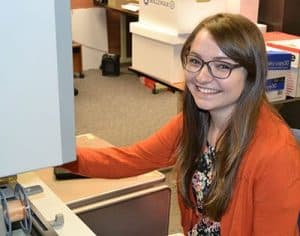Historical Research Center Supports Student Researchers
| July 12, 2016 | Inside gray and white boxes on simple metal shelves in UAMS Library’s Historical Research Center, two student researchers are finding colorful sources and acquiring valuable knowledge about the state’s medical past.

Caitlin Beasley uses a microfilm reader in the Historical Research Center to read through Eureka Springs newspaper editions from the 1880s as part of her research.
Corbin Stinnett of Siloam Springs, a history major and senior at the University of Arkansas, Fayetteville, and Caitlin Beasley of Owasso, Oklahoma, a recent UA graduate with a bachelor’s degree in history, both made research trips to the center in June.
They were supported by grants from the Society for the History of Medicine and Health Professions, an advocacy group for the Historical Research Center. Stinnett received $735, and Beasley, $1,350. The grants are intended to support historical research into Arkansas’ medical past as well as bring attention to the resources of the research center.
“We had a number of good applications this year, and we normally only award one grant annually,” said Mary Ryan, the society’s president and former UAMS Library director. “Both projects were so good that we decided to award two, which is the first time that I know of that happening.”
Beasley plans on adding to the work she already has done in completing her honors thesis, “The Medical Marketing of Eureka Springs, Arkansas,” and hopes to be ready by the end of the summer to submit her research for publication in a historical journal.
Under the direction of Trish Starks, UA associate professor of history, she has studied the promotion of Eureka Springs as place of healing spring waters from its founding in 1879 until the early 1900s.
Just a few hours into her first day of research at the center, Beasley said she found some very helpful letters written by the daughter of one of the many physicians drawn to Eureka Springs to treat the ailing people who traveled there seeking cures.
The daughter was writing to the man whom she would eventually marry.

Corbin Stinnett types in research notes in the center’s reading room. Artifacts related to the state’s history of medicine are on display in glass cases behind him.
“I got some good perspective on the day to day,” Beasley said. “The demand for treatment there was very seasonal. During the winter, it was just dead, but by spring it was booming again. It was great to learn from a first-hand source what that was like.”
Beasley said she also found some copies of the Eureka Springs Medical Journal she hadn’t seen before. Not a traditional medical journal, even for the time, the publication is crammed with advertisements, just the promotional material she needs for her research.
Tim Nutt, director of the center, said he and the center staff were just as delighted to help Beasley and Stinnett as they were to receive the support.
“The Historical Research Center was pleased to host Corbin and Caitlin as they delved into Arkansas’s fascinating medical history,” Nutt said. “Each is an excellent researcher and came prepared to learn more about their respective topics. I have been impressed by their enthusiasm, and I know that both will make significant contributions to the medical history field.”
Stinnett is just digging into the research for his contribution, his honors thesis, “Confronting the Crimson Killer: A Critical Examination of Pellagra Eradication in Arkansas.” Pellagra, a disease resulting from a deficiency of vitamin B3, killed more than 10,000 Arkansans in the early 20th century.
By the 1940s, through improvements in diet and public education about pellagra, it had been eliminated. The national campaign to eradicate it began circa 1902, and many historians have blamed the decades-long duration of the fight on the perceived obstructiveness of Arkansas state health officials. Stinnett disagrees.
“They did not undermine it,” Stinnett said. “They actually supported what the national officials were saying. The national officials see the state officials as just being lazy or not wanting to agree with them, but the state officials were running up against cultural and educational roadblocks that slowed them down.”
For example, nutritional information about the disease and a healthy diet were being placed in school curricula, but some students were needed to work on the farms of their families and left school before they could learn it. Stinnett said the program was being implemented, but just wasn’t effective because of economic and cultural factors like that.
Sources he found in the center’s archives already are helping support his thesis.
“I’ve been finding exactly what I was hoping to find — health education manuals, those sorts of things,” he said. “It’s exceeded my expectations by miles. It really is a very friendly staff to work with. They are eager to help and show you how to research here effectively. The seats are really comfortable, too.”
The Historical Research Center is located on the fifth floor of the UAMS Library and is open from 9:00 a.m.-4:00 p.m. Monday through Friday. The center’s mission is to preserve the institutional record of UAMS, as well as the medical and health sciences history of the state.
